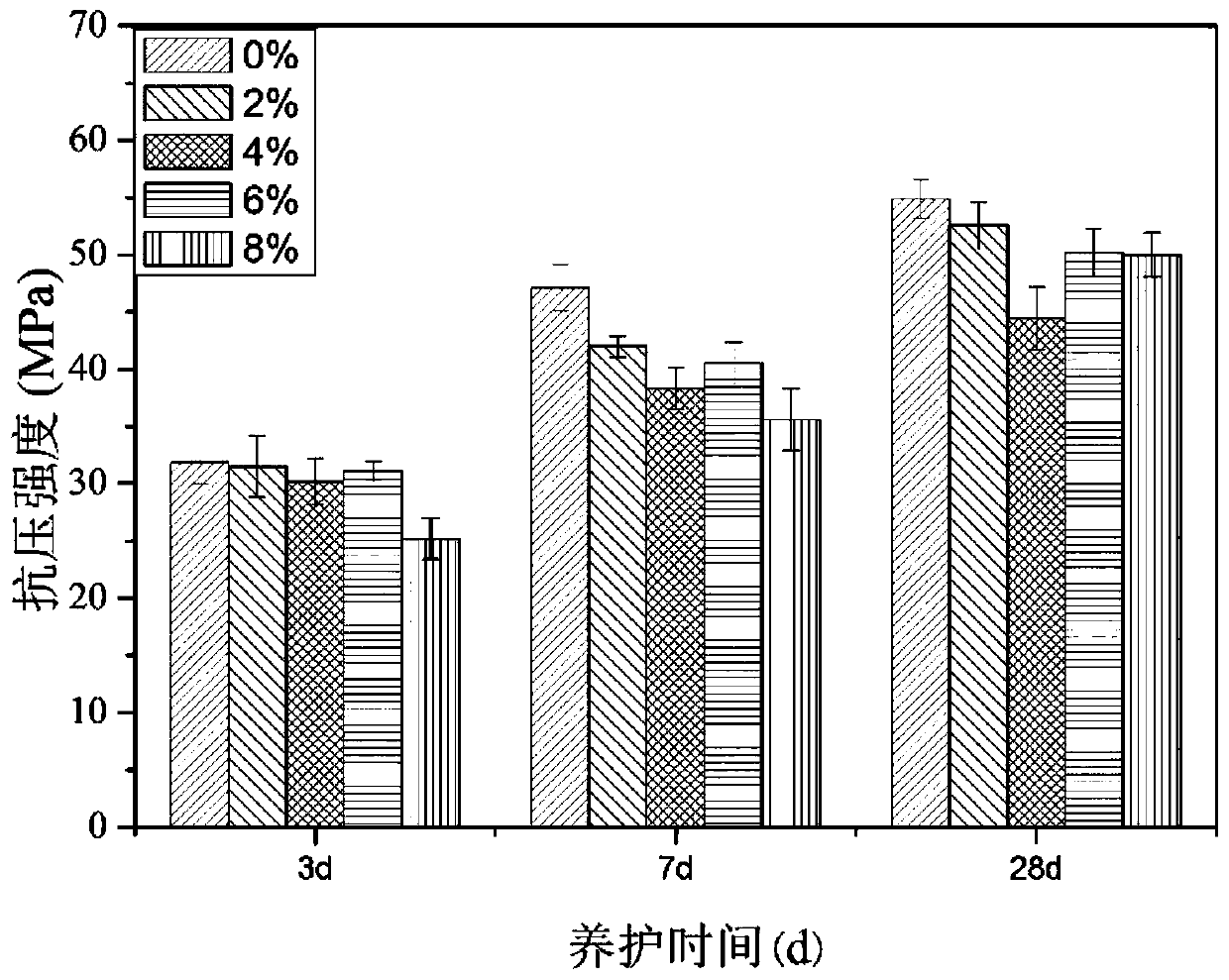Method for preparing nano-modified cement-based biomass material by using high-temperature calcined straw ash
A nano-modification and high-temperature calcination technology, which is applied in the field of building materials, can solve the problems of high preparation cost and poor sulfate corrosion resistance, and achieve improved corrosion resistance, improved compressive strength, and reduced ettringite and calcium hydroxide. Effect
- Summary
- Abstract
- Description
- Claims
- Application Information
AI Technical Summary
Problems solved by technology
Method used
Image
Examples
Embodiment 1
[0045] Plant stalks are crushed and dried to obtain plant powder, which is placed in a ceramic crucible and calcined once at 200°C for 1 hour in a muffle furnace to obtain a sintered powder; the sintered powder prepared above is placed in a ceramic crucible Carry out secondary calcination treatment at 600°C for 6 hours in a muffle furnace to obtain straw ash; in parts by weight, mix 5 parts of acrylic monomer, 0.12 parts of sodium dodecylbenzenesulfonate and 8 parts of deionized water Stir to prepare a monomer emulsion, then add 1 part of nano-silica powder, ultrasonically disperse for 30 minutes at room temperature with a power of 500W, then add 0.1 part of initiator, stir and react at 60°C for 1 hour, cool to room temperature after the reaction, and filter. Wash the solid with absolute ethanol and deionized water in sequence, and dry it at 80°C to obtain a polymer-coated silica material;
[0046] Dissolve 1ml of tetraethyl orthosilicate in 50ml of absolute ethanol, add 3ml o...
Embodiment 2
[0048] Plant stalks are ground and dried to obtain plant powder, which is placed in a ceramic crucible and calcined once at 400°C for 3 hours in a muffle furnace to obtain a sintered powder; the sintered powder prepared above is placed in a ceramic crucible Carry out secondary calcination treatment at 600°C in a muffle furnace for 6 hours to obtain straw ash; in parts by weight, mix 13 parts of acrylic monomer, 0.15 parts of sodium dodecylbenzenesulfonate and 11 parts of deionized water Stir to prepare a monomer emulsion, then add 4 parts of nano-silica powder, ultrasonically disperse at room temperature for 30 minutes at 500W power, then add 0.5 part of initiator, stir and react at 90°C for 2 hours, cool to room temperature after the reaction, filter, Wash the solid with absolute ethanol and deionized water in sequence, and dry it at 80°C to obtain a polymer-coated silica material;
[0049] Dissolve 1ml of tetraethyl orthosilicate in 50ml of absolute ethanol, add 3ml of deion...
Embodiment 3
[0051] Plant stalks are crushed and dried to obtain plant powder, which is placed in a ceramic crucible and calcined once at 200°C for 1.5 hours in a muffle furnace to obtain a sintered powder; the sintered powder prepared above is placed in a ceramic crucible Carry out secondary calcination treatment at 600°C in a muffle furnace for 6 hours to obtain straw ash; in parts by weight, 7 parts of acrylic monomer, 0.13 parts of sodium dodecylbenzenesulfonate and 9 parts of deionized water Mix and stir to prepare a monomer emulsion, then add 2 parts of nano-silica powder, ultrasonically disperse for 30 minutes at room temperature with a power of 500W, then add 0.2 parts of initiator, stir and react at 70°C for 70 minutes, cool to room temperature after the reaction, and filter , washing the solid with absolute ethanol and deionized water in sequence, and drying at 80°C to obtain a polymer-coated silica material;
[0052] Dissolve 1ml of tetraethyl orthosilicate in 50ml of absolute e...
PUM
 Login to View More
Login to View More Abstract
Description
Claims
Application Information
 Login to View More
Login to View More - R&D
- Intellectual Property
- Life Sciences
- Materials
- Tech Scout
- Unparalleled Data Quality
- Higher Quality Content
- 60% Fewer Hallucinations
Browse by: Latest US Patents, China's latest patents, Technical Efficacy Thesaurus, Application Domain, Technology Topic, Popular Technical Reports.
© 2025 PatSnap. All rights reserved.Legal|Privacy policy|Modern Slavery Act Transparency Statement|Sitemap|About US| Contact US: help@patsnap.com



